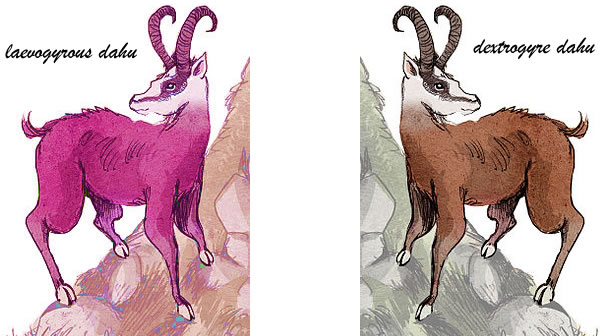If someone sent you to hunt for a dahu, would you go?

In French the expression chasse au dahu (dahu hunt) is one equivalent of a wild goose chase, that is “a wild or absurd search for something nonexistent or unobtainable; any senseless pursuit of an object or end; a hopeless enterprise” [source].
The dahu [da.y], or dahut, is an imaginary creature that lives in mountainous areas of France and Switzerland. According to legend, the dahu looks a bit like a mountain goat or a chamois, and has legs shorter on one side than the other. This makes it easier for it to stay upright on step mountain sloops, but also means that it can only go around the mountain in one direction.
There are two varieties of dahu: the dahu lévogyre [da.y le.vo.ʒiʁ] or laevogyrous dahu, which has shorter legs on the left side, so goes around mountains in an anti-clockwise direction, and the dahu dextrogyre [da.y dɛks.tʁo.ʒiʁ] or dextrogyre dahu, which has shorter legs on the right side, and goes around mountains in the opposite direction. In some stories the dextrogyre dahu are the males and the laevogyrous dahu are the females.
If you want to catch a dahu there are apparently several methods. One involves two people, one with a big bag who waits at the bottom of a mountain, while the other sneaks up behind a dahu and makes a dahu-like sound. The dahu will turn around when it hears the sound, loose its balance and roll down the hill to be caught in the bag. Another method involves putting some pepper on a stone on the mountain. The when a dahu comes to see what’s on the stone, it sniffs the pepper, sneezes and knocks itself out on the stone. A dahu hunt is best undertaken at night and between November to February.
Dahu hunting became popular in mountainous parts of eastern France in the late 19th century, when tourists from urban areas with little knowledge of the countryside started visiting the mountains in large numbers. Local mountain guides would convince some of these guillable visitors to go hunting dahu, and tell them that to catch a rare and precious dahu, they would have to hide themselves on a mountain slope all night.
In Scotland the wild haggis (Haggis scoticus) is sometimes hunted, though rarely caught, and according to American folklore, the sidehill gouger is a beast somewhat like a dahu with legs shorter on one side than the other that lives in the hills of Wisconsin. Such creatures are also known as Sidehill Dodger, Sidehill Galoot, Wampus, Wampahoofus, Boofum, Hunkus, Rickaboo Racker, Prock, Gwinter or Cutter Cuss [source].
The expression wild goose chase first appeared in writing in 1593 in a book about horsemanship by Gervase Markham, an English poet. He describes a type of horse race in which riders try to follow a lead horse taking an erratic course, a bit like wild geese following their leader when flying.
Are there interesting equivalents of a dahu hunt or wild goose chase in other languages?
More information about the Dahu
https://mythus.fandom.com/wiki/Dahu
https://en.wiktionary.org/wiki/dahu
https://en.wikipedia.org/wiki/Dahu
https://fr.wiktionary.org/wiki/dahu
https://fr.wikipedia.org/wiki/Dahu
First, it looks like you’ve given the pronunciation for “dahu lévogyre” instead of “lévogyre dahu”. And second, the myth maker who made male and female of opposite gyration failed to think through some details.